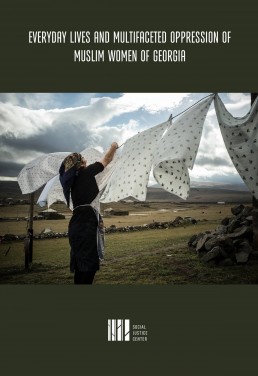საერთო ცხელი ხაზი +995 577 07 05 63


This study seeks to comprehensively describe the difficulties and obstacles faced by women of ethnic and religious minorities in the region of Adjara as well as the Marneuli municipality in Georgia. It is based on research that was inspired by the idea that people’s lives are not impacted by a single axis of power, rather, power should be analyzed as intersectional. In Georgia, the political and economic systems, ethno-religious nationalism and patriarchy are the dominant systems of power that impact the daily lives and conditions of the population. By describing the everyday experiences of Georgian Azerbaijani and Adjarian Muslim women, the study shows how these existing social systems affect people's lives and what kind of axes of power create daily obstacles for them.
The intersectional approach argues for a multifaceted analysis of power and its influence on people’s lives and experiences (Collins and Bilge 2016, 2). The political and social systems underpinning events cannot be explained by a single element; they are always driven by different axes and foundations of power. These axes of power often intersect, cooperate or influence each other. Analyzing people's daily lives, concerns and problems through the lens of intersectionality, therefore, generates a more nuanced and complex perspective. Proponents of the intersectional approach maintain that social divisions such as class, race, ethnicity, gender, sexuality, age, dis/ability, etc. collectively create systems of power that influence people's social positions and status (ibid, 4).
Intersectionality also underscores that there is no uniform understanding of "womanhood" in all groups and contexts; women face different challenges not only in different cultures and societies, but within the same society as well. The category of "woman", therefore, is actually quite diverse and heterogeneous, since various groups of women have different access to power, experience diverse types of oppression and are differently positioned towards men and each other (Mohanty 1984; Narayan 1998; Hooks 2015; Abu-Lughod 2016; Lorde 2021). As a result, it should be kept in mind that women hold diverse positions in everyday life and face different challenges due to the various forms of power acting upon them. The intersectional approach in itself, originated from the ideas of primarily African-American feminists who voiced the concern that the problems and oppression described by white women were not universal within American society because their views only represented the experiences of white, middle-class women.
White, Western feminists imagined their oppression to be universal and viewed the issues faced by other groups (like women of color in their own society and women living outside the West) through a Western, white lens, which prevented them from accurately describing women's lives (Mohanty 1984; Narayan 1998). The movement started by white, middle-class women was blind to and could not voice the circumstances and problems that black women usually faced. For example, black women maintained that class and skin color were both important factors in their day-to-day lives, along with their gender (Hooks 2000; Lorde 2021). They argued that focusing solely on gender erases certain groups of women, such as poor women and women of non-dominant ethnic background, from the feminist agenda, and the broad masses of women are left out of the women’s movements altogether (Crenshaw 1989). According to African-American feminists, for a multifaceted analysis of women’s lives, it is necessary to identify and describe their different positioning within the diverse axes of power (gender, race, class, sexual orientation, etc.) shaping society (Collins and Bilge 2016; Lorde 2021).
This is why advocates of the intersectional analysis argue that it is misleading to declare one element of power as the dominant mechanism of oppression. Rather, it is important to analyze all the axes of power simultaneously and understand how people are embedded and configured within their ‘matrix of domination’ (Collins 1991). Additionally, the proponents of intersectionality situate the groups subjected to multiple forces of domination at the center of their research because this method reveals not only the essence of power, but also the intersections of its multiple axes (ibid.).
The majority of Georgia's population lives in poverty, thereby making material hardships born out of the economic system one of the major axes of power.[1][2] Even the so-called Georgian middle class is becoming increasingly impoverished due to over-indebtedness, ever-increasing housing prices and low wages. After the collapse of the Soviet Union, there was an expectation that the volatile situation created during the transition would eventually stabilize, while people employed in the informal sector would gradually move to the formal sector as capitalism steadily replaced the older socialist system (Verdery 2003; Pedersen 2011; Knudsen and Frederiksen 2015;). However, the middle class is now becoming economically almost as precarious as those below the poverty line. Meanwhile, the lower classes often live without even the most basic benefits, that are supposed to be their social right, like healthcare, education and basic infrastructure[3]. In such an economic and political environment, the social groups living in the periphery like the Adjarians residing in the highland villages and the Georgian Azerbaijanis inhabiting the non-Georgian-speaking villages are even more vulnerable, susceptible and deprived of even the bare minimum of the most fundamental public goods.
Georgian ethno-religious nationalism, which originated in the late 1980s and became the dominant ideology in the 1990s (Jones 2013), is the second major axis of power that significantly affects the lives of ethnic and religious minorities. During this period, civil wars erupted in Georgia and various ethnic minorities fled the Georgian territory. Ethnic confrontations that occurred in several towns in the 1990s have traumatic and tangible consequences for certain groups till this day. Due to the dominant position assumed by ethno-religious nationalism in Georgian society today, ethnic and religious minorities are often labeled as strangers, guests, and sometimes even enemies, despite the official recognition of the principle of equality within the legislative framework. Ethno-religious nationalism represents the ethnic and religious majority in Georgia as a group that deserves more privilege, while other groups become a “problem” that the Georgian state must "deal with." Although the Constitution of Georgia does not differentiate between Georgian citizens on the basis of ethnicity, ethno-religious nationalist ideas are so dominant that they become an integral part of the everyday language of government officials, and they even appear in the teaching materials used in schools, including history textbooks[4]. These rhetorical and political practices exclude certain groups from realizing the full potential of their Georgian citizenship. The inequalities based on ethno-religious nationalism get intertwined with the hierarchies created by Georgia's economic and political system, and as a result, ethnic minority regions are even poorer and less developed than the rest of the country, and the access to education, employment and healthcare is even more difficult[5].
Finally, gender is the third major axis of power in today’s Georgia that can largely determine the direction of one’s life, and for many women, it is often an important reason for getting fewer opportunities and facing many obstacles. Religious and ethnic minorities are not an exception, since women from such groups face even more barriers than men in terms of political participation, healthcare, education and employment.[6] Unfortunately, the only aspect of the oppression of women from ethnic and religious minority groups that often gets highlighted is the culturally and religiously determined patriarchy within these communities; the patriarchy that generally prevails in Georgia as well as other facets of power that affect women’s lives are often completely dismissed. It is therefore necessary to talk about the patriarchy experienced by the women of these minority groups in a contextual manner, and discussions of their problems and oppression should take place without the use of Orientalist stereotypes. Moreover, while the concept of "freedom", or lack thereof, is often raised in the context of the oppression of Georgian Azerbaijani and Adjarian Muslim women in the country, other social, political and economic issues faced by these minority women usually remain forgotten. This is why it is important to explore the daily challenges of these women from an intersectional perspective. Such an analysis has the potential to create fairer conditions for the aforementioned groups by bringing about positive changes directed against the multidimensional domination in their everyday lives.
The website accessibility instruction